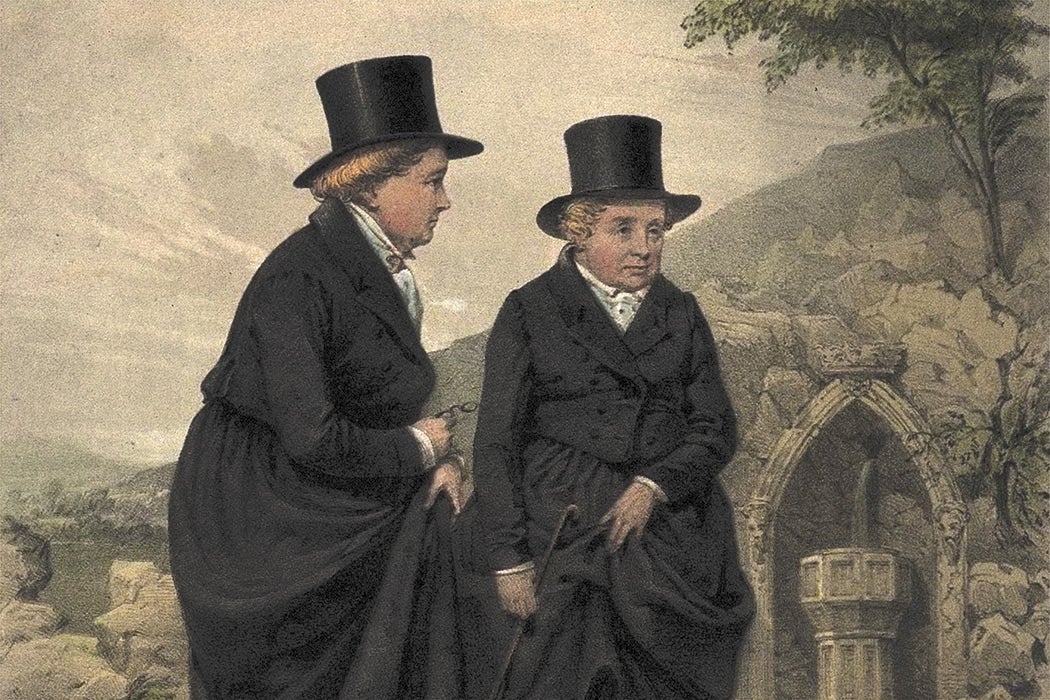Princesses, dukes, and lords ventured to the picturesque village of Llangollen, Wales, to fête two pink-cheeked women in top hats. Possibly more interesting “commoners,” like Erasmus Darwin and his grandson Charles, also called on them. They were the Ladies of Llangollen, and their reputation lived on after their time through dedications to poems by the likes of Wordsworth, Southey, and Byron. In fact, ceramic tchotchkes of them graced Victorian homes long after they passed away.
Irishwomen Eleanor Butler (1739–1828) and Sarah Ponsonby (1755–1831) faced a mutual crisis in 1778. The pair had been close since the orphaned Ponsonby had had Butler as a teacher, but what independent scholar Eugene Coyle calls their “intense” relationship was unacceptable to their families. With Butler unmarried at the age of forty, her aristocratic, Irish Catholic family was planning to put her into a convent. At the same time, Ponsonby’s Anglican, Anglo-Irish guardians were trying to marry her off.
The pair rebelled, daringly trying to escape together across the Irish Sea, dressed as men and armed for danger. They were found out and separated, but they made another effort soon after. Again, they were discovered. Finally, accompanied by Ponsonby’s maid, they crossed over to northern Wales. They settled into what they called “exquisite retirement.”
Many people today would instantly wonder whether Butler and Ponsonby were lesbians. Coyle notes that “there has been considerable debate, during their lifetime and after, on the nature of the relationship between the two ladies.” But it’s not so clear-cut.
English and gender studies professor Nicole Reynolds is somewhat more direct, calling the Ladies’ celebrated escape from Ireland an “elopement” and their relationship a “romantic friendship.” This form of “female same-sex intimacy” was “very popular and pervasive” in the eighteenth century; it “created a space for the expression of sexual identity that might today be called lesbian.”
But wait. Why weren’t the Ladies run out of Llangollen, then? Coyle suggests that different standards for male and female homosexuality prevailed. “Public attitudes towards lesbians or sapphites were ambiguous, as sex between women was not illegal,” he explains, but adds that “sodomy or male homosexuality had been brutally suppressed by law since the early fourteenth century.”
Reynolds writes that the Ladies of Llangollen carefully constructed, and tied hard to control, the “public myth of themselves” against “insinuations of sexual impropriety.” Domesticity was the solution. The two women transformed their “low-roofed Cot,” as Wordsworth described it, into a “heavily ornamented, artfully contrived spectacle, a cottage ornée” that became a pilgrimage site, even after the Ladies had passed away.
Weekly Newsletter
Named Plas Newydd, Welsh for New Hall, the cottage “held a privileged place in the cultural imagination[.]” By opening their home to visitors and “selectively” circulating images of the Gothic structure, Reynolds writes, the ladies “presented to women a viable alternative to the impositions of patriarchal domestic arrangements.”
That alternative, of course, included dogs. As Coyle relates, the ladies named a “succession of their pet dogs ‘Sappho’.”







